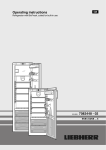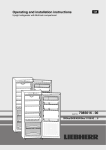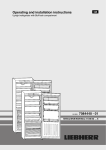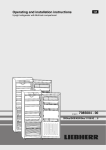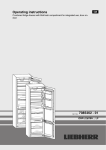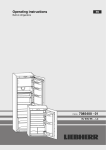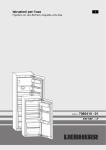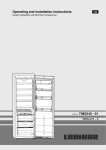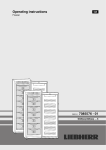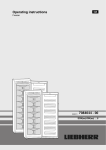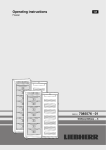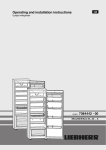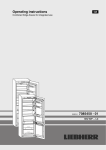Download Liebherr IKBP 2954 Premium BioFresh
Transcript
Operating instructions Refrigerator with BioFresh compartment for integrated use, door-on-door 200514 7085410 - 01 IKB/ IKBP ... LP Appliance at a glance 1 Appliance at a glance Contents 1 1.1 1.2 1.3 1.4 Appliance at a glance............................................ Description of appliance and equipment.................. Range of appliance use............................................ Conformity................................................................ Saving energy.......................................................... 2 2 2 3 3 2 General safety information................................... 3 3 3.1 3.2 Controls and displays........................................... Operating and control elements............................... Temperature display................................................. 4 4 4 4 4.1 Putting into operation............................................ Switching on the appliance....................................... 4 4 5 5.1 5.2 5.3 5.4 5.5 Control.................................................................... Child proofing........................................................... Door alarm................................................................ Refrigerator compartment........................................ BioFresh compartment............................................. Freezer compartment............................................... 4 4 5 5 7 8 6 6.1 6.2 6.3 Maintenance........................................................... Defrosting................................................................. Cleaning the appliance............................................. Customer service..................................................... 9 9 9 9 7 Malfunction............................................................. 10 8 8.1 8.2 Decommissioning.................................................. 11 Switching off the appliance....................................... 11 Taking the appliance out of service.......................... 11 9 Disposing of the appliance................................... 11 The manufacturer works constantly on the further development of all the types and models. Therefore please understand that we have to reserve the right to make design, equipment and technical modifications. To get to know all the benefits of your new appliance, please read the information contained in these instructions carefully. The instructions apply to several models. Differences may occur. Text relating only to specific appliances is marked with an asterisk (*). Instructions for action are marked with a action are marked with a . , the results of 1.1 Description of appliance and equipment Fig. 1 (1) Operating and control elements (2) Freezer compartment (3) Fan (4) LED light column, double sided (5) Shelf (6) Shelf, sectioned (7) VarioSafe* (8) Adjustable bottle shelf* (9) Package rack (10) Can rack (11) Bottle rack (12) Bottle holder (13) LED lighting, BioFresh compartment (14) DrySafe (15) Humidity control plate (16) HydroSafe (17) Drain hole (18) Soft stop mechanism (19) Type plate Note u Place food inside the appliance as shown in the diagram. This allows the appliance to save energy during operation. u Shelves, drawers and baskets are arranged for optimum energy efficiency on delivery. 1.2 Range of appliance use Intended use The appliance is suitable solely for cooling food in a domestic environment or similar. This includes use in, for example - in staff kitchenettes, bed and breakfast establishments, - by guests in country cottages, hotels, motels and other accommodation, - for catering and similar services in the wholesale trade. 2 * Depending on model and options General safety information Use the appliance solely in a domestic type of environment. All other applications are inadmissible. Foreseeable misuse The following applications are expressly prohibited: - Storage and cooling of medicines, blood plasma, laboratory compounds or similar materials and products subject to the Medical Devices Directive 2007/47/EC - Use in potentially explosive areas Improper use of the appliance can lead to damage to or spoilage of the stored goods. Climate rating definitions The appliance is set to operate within specific ambient temperature limits according to its climate rating. The correct climate rating for your appliance is indicated on the type plate. - Ensure that all food is well packed and covered for storage. This will prevent frost from forming. - Remove food as needed in order that it does not warm too much. - First cool warm food to room temperature before storing it . - Defrost frozen food in the refrigerator.* - If there is a thick layer of frost in the appliance: defrost the appliance.* 2 General safety information Danger for the user: - This appliance can be used by children of 8 years old and over, and also by persons with restricted physical, sensory or mental capacity or lack of experience and knowledge, if they are supervised or have been instructed on safe use of the appliance and understand the resulting risks. Children must not be allowed to play with the appliance. Cleaning and user maintenance must not be carried out by children without supervision. Note - When disconnecting the appliance from the uCompliance with the ambient temperatures supply, always take hold of the plug. Do not indicated is required, otherwise the cooling pull the cable. performance is reduced. - In the event of a fault pull out the mains plug or deactivate the fuse. Climate for ambient temperatures of - Do not damage the mains power cable. Do rating not operate the appliance with a defective SN 10 °C to 32 °C mains power cable. N 16 °C to 32 °C - Have any repairs to or intervention in the ST 16 °C to 38 °C appliance, and any change of the mains T 16 °C to 43 °C power cable, carried out by the customer service only or by other specialised personnel trained for the purpose. 1.3 Conformity - Only install, connect and dispose of the appliThe refrigerant circuit is tested for leakage. When built-in the ance according to the instructions. appliance complies with the relevant safety regulations and EC Directives 2006/95/EC, 2004/108/EC, 2009/125/EC and - Only use the appliance when it is installed. 2010/30/EU. - Please keep these instructions in a safe place The BioFresh compartment satisfies the requirements of a chill and pass them on to any subsequent owners. compartment to EN ISO 15502. - Special-purpose lamps (incandescent lamps, Note for test institutions: LEDs, fluorescent tubes) in the appliance Tests are to be carried out according to the applicable serve to illuminate the appliance interior and standards and guidelines. are not suited for room illumination. Preparation and testing of the appliances must be carried out taking the manufacturer's loading plans and the Fire hazard: notes in the operating manual into account. - The refrigerant R 600a is environmentally friendly but flammable. Escaping refrigerant 1.4 Saving energy may ignite. - Always ensure good ventilation. Do not cover ventilation • Do not damage the refrigerant circuit pipes. openings or grille. • Do not allow naked flames or ignition - Always keep fan louvres clear. - Do not place appliance in areas of direct sunlight or next to a sources to enter the appliance. stove, heater or similar object. • Do not use any electrical appliances in the - The energy consumption depends on the installation condiinterior (e.g. steam cleaners, heaters, ice tions, e.g. the ambient temperature (see 1.2) . - Keep the time the appliance is open to a minimum. cream maker etc.). - The lower the temperature setting, the higher the power • If refrigerant escapes: remove any naked consumption. flames or sources of ignition from the - Store food logically. (see Appliance at a glance). * Depending on model and options 3 Controls and displays leakage area. Ventilate the room well. Notify the after-sales service. - Do not store explosives or sprays using combustible propellants such as butane, propane, pentane, etc. in the appliance. To identify these spray cans, look for the list of contents printed on the can, or a flame symbol. Gases possibly escaping may ignite due to electrical components. - Please be sure to store alcoholic drinks or other packaging containing alcohol in tightly closed containers. Any alcohol that leaks out may be ignited by electrical components. Danger of tipping and falling: - Do not misuse the plinth, drawers, doors etc. as a step or for support. This applies particularly to children. Danger of food poisoning: - Do not consume food which has been stored too long. Danger of frostbite, numbness and pain: - Avoid lasting skin contact with cold surfaces or refrigerated/frozen food or take protective steps, e.g. wear gloves. Do not consume ice cream, water ice or ice cubes immediately and do not consume them too cold. Danger of injury and damage: - Hot steam can lead to injury. Do not use electrical heating or steam cleaning equipment, open flames or defrosting sprays to defrost. - Do not use sharp implements to remove the ice. Risk of crushing - Do not reach into the soft stop mechanism. Fingers may be trapped when the door is closed. Please observe the specific information in the other sections: 4 DANGER identifies a situation involving direct danger which, if not obviated, may result in death or severe bodily injury. WARNING identifies a dangerous situation which, if not obviated, may result in death or severe bodily injury. CAUTION identifies a dangerous situation which, if not obviated, may result in minor or medium bodily injury. NOTICE identifies a dangerous situation which, if not obviated, may result in damage to property. Note identifies useful information and tips. 3 Controls and displays 3.1 Operating and control elements Fig. 2 (1) On/Off button (2) Temperature display (3) Up setting button (4) Down setting button (5) SuperCool button (6) (7) (8) (9) SuperCool symbol Alarm button Menu symbol Child lock symbol 3.2 Temperature display The following are displayed in normal operation: - the average cooling temperature The following displays indicate malfunction. Possible causes and corrective action (see Malfunction). - F0 to F9 4 Putting into operation 4.1 Switching on the appliance Switch on the appliance approx. 2 hours before adding frozen food for the first time.* u u w w w Open the door. Press On/Off button Fig. 2 (1). The temperature display indicates the current temperature. The interior light is on when the door is open. If “DEMO” is displayed, demo mode is activated. Please contact the after sales service. 5 Control 5.1 Child proofing The child-proofing function enables you to make sure that the appliance is not inadvertently switched off by playing children. 5.1.1 Setting the child lock function u To activate the setting mode: press SuperCool button Fig. 2 (5) for about 5 s. w The display indicates c. w The menu symbol Fig. 2 (8) shines. u Briefly press theSuperCool button Fig. 2 (5) to confirm. * Depending on model and options Control When c1 is indicated in the display: u to activate the child lock, briefly press the SuperCool button Fig. 2 (5). w The child lock symbol Fig. 2 (9) shines. c flashes in the display. When c0 is indicated in the display: u to deactivate the child lock, briefly press the SuperCool button Fig. 2 (5). w The child lock symbol Fig. 2 (9) goes out. c flashes in the display. u To deactivate the set-up mode: press On/Off button Fig. 2 (1). -oru Wait for 5 minutes. w The temperature is indicated again in the temperature display. 5.2 Door alarm If the door is open for longer than 60 seconds, the audible warning will sound. The audible alarm is automatically silenced when the door is closed. 5.2.1 Muting the door alarm The audible alarm can be muted when the door is open. The sound switch-off function is active as long as the door is left open. u Press alarm button Fig. 2 (7). w The door alarm is silenced. 5.3 Refrigerator compartment The natural circulation of air in the refrigerator compartment results in zones differing in temperature. It is coldest directly above the plate separating off the BioFresh zone and at the rear wall. It is warmest at the top front of the compartment and in the door. 5.3.1 Food refrigeration u Place butter and preserves in the upper area and in the door (see Appliance at a glance). u Use recyclable plastic, metal, aluminium and glass containers and cling film for wrapping. u Always store liquids and food which is subject to odour or taste transfer in closed containers or cover them. u Foods which give off a large amount of ethylene gas and delicate foods, such as fruit, vegetables, salad, should always be stored separately or wrapped so as not to reduce the storage life; e.g. do not store tomatoes together with kiwis or cabbage. u Use the front area of the refrigerator compartment floor only for briefly putting down cooled products, e.g. when rearranging and sorting. However do not leave cooled products there otherwise they may be pushed back or tipped over when the door is closed. u Do not store food too close together to enable good air circulation. 5.3.2 Setting the temperature The temperature depends on the following factors: - the frequency of opening the door - the room temperature of the installation location - the type, temperature and quantity of the food * Depending on model and options The temperature can be set from 9 °C to 3 °C, the recommended temperature is 5 °C. An average temperature of about –18 °C is reached in the freezer compartment.* Note If the temperature is to be colder than 3 °C: u set the cooling temperature to 3 °C. u Set the BioFresh temperature to a value between (slightly colder) and b1 (coldest) (see 5.4) b4 u For a higher temperature setting: press Up button Fig. 2 (3). u For a lower temperature setting: press Down button Fig. 2 (4). w When the button is pressed the first time, the previously set value is indicated, flashing, in the temperature display. u To change the temperature in 1 °C steps: briefly press the button. u To change the temperature continuously: hold down the button. w The value is displayed flashing during the setting operation. w The actual temperature is displayed about 5 s after the last press of a button. The temperature slowly adjusts to the new value. 5.3.3 SuperCool With SuperCool you switch to the highest cooling performance to reach lower cooling temperatures. Use SuperCool, to rapidly cool large amounts of food. The SuperCool function uses slightly more energy. Cooling with SuperCool u Briefly press SuperCool button Fig. 2 (5). w The SuperCool symbol Fig. 2 (6) lights up in the display. w The cooling temperature drops to the coldest value. SuperCool is activated. w SuperCool is automatically deactivated after 12 hours. The appliance continues to operate in the energy-saving, normal mode. To prematurely deactivate SuperCool u Briefly press SuperCool button Fig. 2 (5). w The SuperCool symbol Fig. 2 (6) goes out in the display. w SuperCool is deactivated. 5.3.4 Shelves Moving or removing shelves The shelves have stops preventing them from being unintentionally pulled out. Fig. 3 u Lift the shelf slightly and pull forward a little. u Adjust the height of the shelf. To do so, push the cut-outs along the supports. u Only a short shelf may be inserted in front of the fan. * u In order to remove the shelf fully, place it at a slant and pull out towards the front. u Re-insert shelves at the required height. The stops must face downwards and lie behind the front shelves. 5 Control Dismantling shelves u The shelves can be dismantled for cleaning. Dismantling VarioSafe* 5.3.5 Using the sectioned shelf u Slide the sectioned shelf under, as shown in the illustration. Fig. 6 u The VarioSafe can be dismantled for cleaning. 5.3.8 Door racks Moving the storage rack Fig. 4 u The glass plate (1) with pull-out stops must be at the front so that the stops (3) face downwards. u When dealing with appliances with a freezer compartment, do not attach trayslides and sectioned shelves in front of the fan.* 5.3.6 Using adjustable bottle shelf At the base of the refrigerator compartment, the integrated bottle shelf or alternatively the glass shelf can be used: u Using the bottle shelf: to save space, store the glass shelf under the bottle shelf. u Place the bottles with the base pointing backwards facing the rear wall. If the bottles project beyond the bottle shelf: u set the lower door rack one position higher. 5.3.7 VarioSafe* Fig. 7 The boxes can be removed and placed on the table as a single unit. Either one or both the boxes can be used. If particularly tall bottles are to be stored, hang only a single box above the bottle rack. u Re-positioning the boxes: Lift them for removal and reposition them as required. The VarioSafe provides space for small items of food and packages, tubes and jars. Using VarioSafe* Dismantling door racks Fig. 5 u The VarioSafe drawer can be taken out and pushed in at two different heights. u The VarioSafe can also be height-adjusted as a whole. Fig. 8 6 * Depending on model and options Control u To prevent food spoilage due to transfer of germs: Store unwrapped animal and vegetable products separate from one another in the drawers. This also applies to different sorts of meat. If food has to be stored together due to lack of space: u wrap the food. 5.4.5 Storage times Standard values for storage time at low humidity Fig. 9 u The door racks can be dismantled for cleaning. 5.3.9 Using the bottle holder u To avoid the bottles tipping over, push the bottle holder along. Butter up to 90 days Hard cheese up to 110 days Milk up to 12 days Sausage, cold meat up to 9 days Poultry up to 6 days Pork up to 7 days Beef up to 7 days Game up to 7 days Note u Please note that protein-rich food deteriorates faster, i.e. shellfish and crustaceans deteriorate faster than fish, fish faster than meat. 5.4 BioFresh compartment The BioFresh compartment allows some types of fresh food to be stored up to three times longer than in conventional refrigerators, without compromising quality. For food with an indicated best before date, the date specified on the packaging always applies. 5.4.1 DrySafe The DrySafe is suitable for storing dry or wrapped food (e.g. dairy products, meat, fish, sausages). A relatively dry storage climate is established here. 5.4.2 HydroSafe The HydroSafe at the moist setting is suited for storing unwrapped salad, vegetables and fruit with high inherent moisture. When the drawer is well filled, a dewy climate with up to 90% humidity is established. The humidity in the compartment depends on the moisture content of the food stored and on the opening frequency. You can set the humidity yourself. 5.4.3 Setting the humidity in the HydroSafe u u Low humidity: move the regulator to the left. High humidity: move the regulator to the right. 5.4.4 Storing food Note u Vegetables sensitive to cold, such as cucumbers, aubergines, semi-ripe tomatoes, zucchinis and all tropical fruits sensitive to cold, do not belong in the BioFresh compartment. * Depending on model and options Standard values for storage time at high humidity Vegetables, salad Artichokes up to 14 days Celery up to 28 days Cauliflower up to 21 days Broccoli up to 13 days Chicory up to 27 days Lamb's lettuce up to 19 days Peas up to 14 days Kale up to 14 days Carrots up to 80 days Garlic up to 160 days Kohlrabi up to 55 days Lettuce up to 13 days Herbs up to 13 days Leek up to 29 days Mushrooms up to 7 days Radishes up to 10 days Brussels sprouts up to 20 days Asparagus up to 18 days Spinach up to 13 days Savoy cabbage up to 20 days Apricots up to 13 days Apples up to 80 days Pears up to 55 days Blackberries up to 3 days Fruit 7 Control Standard values for storage time at high humidity u Pull out the drawer, lift it at the back and draw it forwards for removal. u Push the rails in again! Dates up to 180 days Strawberries up to 7 days Figs up to 7 days Blueberries up to 9 days Raspberries up to 3 days Currants up to 7 days Sweet cherries up to 14 days Kiwis up to 80 days u Push the rails in. u Attach the drawer and push it in until it engages audibly at the back. Peaches up to 13 days 5.4.8 Humidity control plate Plums up to 20 days Cranberries up to 60 days Rhubarb up to 13 days Gooseberries up to 13 days Grapes up to 29 days 5.4.6 Adjusting the temperature in the BioFresh compartment The temperature is controlled automatically. At a temperature in the refrigerator compartment of 5 °C, the temperature in the BioFresh compartment is between 0 °C and 3 °C. You can adjust the temperature slightly colder or warmer. The temperature can be adjusted from b1 (coldest temperature) to b9 (warmest temperature). The presetting is b5. At the b1 to b4 settings the temperature may drop below 0 ° C and therefore the food may freeze slightly. u To activate the setting mode: press the SuperCool button Fig. 2 (5) for about 5 s. w The menu symbol Fig. 2 (8) shines. The temperature display indicates c . u Press the Up setting button Fig. 2 (3) the number of times required for b to flash in the display. u To confirm: briefly press the SuperCool button Fig. 2 (5). u For a warmer temperature adjustment: press Up setting button Fig. 2 (3). u For a colder temperature adjustment: press Down setting button Fig. 2 (4). u To confirm: press SuperCool button Fig. 2 (5). w The temperature slowly adjusts to the new value. u To deactivate the setting mode: press the On/Off button Fig. 2 (1). -oru Wait for 5 minutes. Fig. 11 Fig. 12 u To remove the humidity control plate: Having removed the drawers, carefully draw the plate forwards and lower it for removal. u To insert the humidity control plate: Insert the cover mouldings of the plate into the rear holder Fig. 12 (1) from underneath and engage them in the holder Fig. 12 (2) at the front. 5.5 Freezer compartment* You can store frozen food for several months, make ice cubes and freeze fresh food in the freezer compartment at a temperature of -18 °C and lower. The air temperature in the compartment, measured by thermometer or other instruments, may fluctuate. 5.5.1 Freezing food* 2 kg fresh food/24 h is the maximum weight which can be frozen. CAUTION Risk of injury due to broken glass! Bottles and cans containing drinks may burst when being frozen. This applies particularly to sparkling drinks. u Do not freeze bottles and cans containing drinks! u 4 h before freezing food, set the temperature to 5 °C or colder. u Switch on SuperCool when loading with food and drink (see 5.3.3) . w The temperature is indicated again in the temperature display. In order that the food is rapidly frozen through to the core, do not exceed the following quantities per pack: - Fruit, vegetables up to 1 kg - Meat up to 2.5 kg u Pack the food in portions in freezer bags, reusable plastic, metal or aluminium containers. 5.4.7 Drawers with cushioners 5.5.2 Storage times* Guide times for storing various types of food in the freezer compartment: Fig. 10 8 Ice cream 2 to 6 months Sausage, ham 2 to 6 months Bread, bakery products 2 to 6 months * Depending on model and options Maintenance Guide times for storing various types of food in the freezer compartment: Game, pork 6 to 10 months Fish, fatty 2 to 6 months Fish, lean 6 to 12 months Cheese 2 to 6 months Poultry, beef 6 to 12 months Vegetables, fruit 6 to 12 months Storage times given are guide times. 5.5.3 Thawing food* u in the refrigerator compartment in a microwave oven in a conventional or fan oven at room temperature Remove only as much food as is required. Use thawed food as quickly as possible. u Food once thawed should be re-frozen only in exceptional cases. 6 Maintenance 6.1 Defrosting 6.1.1 Defrosting refrigerator compartment 6.2 Cleaning the appliance WARNING Risk of injury and damage as a result of hot steam! Hot steam can lead to burns and can damage the surfaces. u Do not use any steam cleaners! NOTICE Incorrect cleaning damages the appliance! u Do not use cleaning agents in concentrated form. u Do not use any scouring or abrasive sponges or steel wool. u Please do not use any aggressive, scouring, sand-, chloride-, chemical- or acid-based cleaning agents. u Do not use chemical solvents. u Do not damage or remove the type plate on the inside of the appliance. It is important for the customer service. u Do not pull off, bend or damage cables or other components. u Do not allow any cleaning water to enter the drain channel, ventilation grille or electrical parts. u Please use soft cleaning cloths and a universal pH-neutral cleaning agent. u Please use cleaning and care products suitable for contact with foodstuffs in the appliance interior. u Empty appliance. u Pull out the power plug. u Clean plastic outer and inner surfaces with lukewarm water and a little washing-up liquid. The refrigerator compartment is defrosted automatically. The water evaporates. Drops of water on the rear wall are functionally conditioned and perfectly normal. u Clean the drain hole at regular intervals to allow the defrost water to drain (see 6.2) . 6.1.2 Defrosting freezer compartment* A layer of frost and ice forms in the freezer compartment after the appliance has been in use for a lengthy period of time. This is quite normal. The layer of frost and ice forms more quickly if the door is opened frequently or if the food is warm when placed inside. However, a thick layer of ice will increase the appliance‘s energy consumption. You should therefore defrost the appliance regularly. CAUTION Risk of injury and damage as a result of hot steam! u Do not use electric heaters or steam cleaners, naked flames or defrosting sprays for defrosting. u Do not remove ice using sharp instruments. u Switch off the appliance. w The temperature display goes out. w If the temperature display does not go out, the child-proofing function (see 5.1) is active. u Pull out the plug. u Wrap the frozen food in newspaper or blankets and store in a cool place. u Leave the compartment and appliance door open during defrosting. u Remove detached pieces of ice. u Pay attention that the defrost water does not run into the kitchen unit. u If necessary, pick up defrost water several times, using a sponge or cloth. u Clean the compartment (see 6.2) . * Depending on model and options drain hole: Remove u Clean deposits with a narrow instrument, e.g. a cotton bud. * * u Most of the parts can be dismantled for cleaning: see the relevant chapter. u The door interior parts are dishwasher-safe. However, the printing may dissolve over time. u Clean other items of equipment by hand with lukewarm water and a little washing-up liquid. u Only use a damp cloth to clean the telescopic rails. The grease in the runners is for lubrication purposes and must not be removed. After cleaning: u Wipe dry the appliance and items of equipment. u Connect the appliance and switch it on again. u Put the food back inside. 6.3 Customer service First check whether you can correct the fault yourself by reference to the list (see Malfunction). If this is not the case, please contact the customer service whose address is given in the enclosed customer service list. 9 Malfunction u The sound is normal. WARNING Risk of injury if repair work is not carried out professionally! u Have any repairs and action - not expressly specified - on the appliance and mains cable carried out by service personnel only. (see Maintenance) u Read the appliance designation Fig. 13 (1), service No. Fig. 13 (2) and serial No. Fig. 13 (3) off the type plate located inside the appliance on the lefthand side. A hum. It is briefly a little louder when the refrigeration unit (the motor) switches on. → The refrigeration increases automatically when the SuperCool function is activated, fresh food has just been placed in the appliance or the door has been left open for a while. u The sound is normal. → The ambient temperature is too high. u Solution: (see 1.2) A low hum. → The sound is produced by air flow noise of the fan. u The sound is normal. Fig. 13 u Notify the customer service, specifying the fault, appliance designation Fig. 13 (1), service No. Fig. 13 (2) and serial No. Fig. 13 (3). w This will help us to provide you with a faster and more accurate service. u Keep the appliance closed until the customer service arrives. w The food will stay cool longer. u Pull out the mains plug (not by pulling the connecting cable) or switch off the fuse. 7 Malfunction Your appliance is designed and manufactured for a long life span and reliable operation. If a malfunction nonetheless occurs during operation, check whether it is due to a handling error. In this case you will have to be charged for the costs incurred, even during the warranty period. You may be able to rectify the following faults yourself: Appliance does not work. → The appliance is not switched on. u Switch on the appliance. → The power plug is not properly inserted in the wall socket. u Check power plug. → The fuse of the wall socket is not in order. u Check fuse. The compressor runs for a long time. → The compressor switches to a low speed when little cold is needed. Although the running time is increased as a result, energy is saved. u This is normal in energy-saving models. → SuperCool is activated. u The compressor runs for longer in order to rapidly cool the food. This is normal. A LED on the bottom rear of the appliance (at the compressor) flashes repeatedly every 5 seconds*. → There is a fault. u Please contact the after-sales service (see Maintenance). Excessive noise. → Due to the various speed steps, speed-regulated* compressors can generate different running noises. u The sound is normal. A bubbling and gurgling noise. → This noise comes from the refrigerant flowing in the refriger- Vibratory noise. → The appliance is not fixed to the ground. The running of the cooling unit therefore makes objects and adjacent furniture vibrate. u Check installation and reposition appliance as required. u Move bottles and containers apart. Flow sound at the soft stop mechanism. → The noise is produced when the door is opened and closed. u The sound is normal. The temperature display indicates: F0 to F9 → There is a fault. u Please contact the after-sales service (see Maintenance). DEMO shines in the temperature display. → The demo mode is activated. u Please contact the after-sales service (see Maintenance). The outer surfaces of the appliance are warm*. → The heat of the refrigeration circuit is used to prevent condensate from forming. u This is normal. The temperature is not cold enough. The door of the appliance is not properly closed. Close the door of the appliance. Insufficient ventilation. Clear ventilation grilles. The ambient temperature is too high. Solution: (see 1.2) . The appliance was opened too frequently or for too long. Wait to see whether the appliance reaches the required temperature by itself. If not, please contact the after sales service (see Maintenance). → The temperature is incorrectly set. u Set the temperature to a colder setting and check after 24 hours. → The appliance is too close to a source of heat (stove, heater etc). u Change the position of the appliance or the source of heat. → The appliance was not inserted properly into the recess. u Check whether the appliance was inserted correctly and the door closes properly. The interior light is not on. → The appliance is not switched on. u Switch on the appliance. → The door was open longer than 15 min. u The interior light automatically switches off if the door has been open for about 15 min. → The LED illumination is defective or the cover is damaged: → u → u → u → u ation circuit. u The sound is normal. A quiet clicking noise. → The noise is produced whenever the refrigeration unit (motor) automatically switches on or off. 10 * Depending on model and options Decommissioning WARNING Risk of injury due to electric shock! Live parts are located under the cover. u Have the LED interior light changed or repaired only by the customer service or by specialized personnel trained for the purpose. WARNING Danger of injury by LED lamp! The light intensity of the LED illumination corresponds to laser class 1/1M. If the cover is defective: u Do not look into the illumination with optical lenses from the immediate proximity. This can cause injury to the eyes. The door gasket is defective or should be replaced for other reasons.* → In some units, the seal around the door can be replaced. You will not need any special tools to do this. u Please contact the after-sales service (see Maintenance). The unit has iced up or condensation has formed.* → The door seal may have also slipped out of its groove. u Check to ensure that the door seal is seated properly in the groove. 8 Decommissioning 8.1 Switching off the appliance u Press On/Off button Fig. 2 (1) for approx. 2 seconds. w A long beep is emitted. The temperature display is dark. The appliance is switched off. w If the appliance cannot be switched off, the child lock function is active (see 5.1) . 8.2 Taking the appliance out of service u Empty the appliance. u Pull out the power plug. u Clean the appliance (see 6.2) . u Leave the door open to prevent odour. 9 Disposing of the appliance The appliance contains some reusable materials and should be disposed of properly - not simply with unsorted household refuse. Appliances which are no longer needed must be disposed of in a professional and appropriate way, in accordance with the current local regulations and laws. When disposing of the appliance, ensure that the refrigeration circuit is not damaged to prevent uncontrolled escape of the refrigerant it contains (data on type plate) and oil. u Disable the appliance. u Pull out the plug. u Cut through the connecting cable. * Depending on model and options 11 Liebherr Hausgeräte Ochsenhausen GmbH * Memminger Strasse 77-79 * 88416 Ochsenhausen * Deutschland * www.liebherr.com












